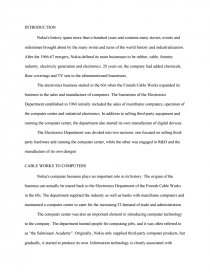Nokia Nature of Business
Essay by review • February 9, 2011 • Research Paper • 2,553 Words (11 Pages) • 4,306 Views
INTRODUCTION
Nokia's history spans more than a hundred years and contains many stories, events and milestones brought about by the many twists and turns of the world history and industrialization. After the 1966-67 mergers, Nokia defined its main businesses to be rubber, cable, forestry industry, electricity generation and electronics. 20 years on, the company had added chemicals, floor coverings and TV sets to the aforementioned businesses.
The electronics business started in the 60s when the Finnish Cable Works expanded its business to the sales and manufacture of computers. The businesses of the Electronics Department established in 1960 initially included the sales of mainframe computers, operation of the computer center and industrial electronics. In addition to selling third-party equipment and running the computer center, the department also started its own manufacture of digital devices.
The Electronics Department was divided into two sections: one focused on selling third-party hardware and running the computer center, while the other was engaged in R&D and the manufacture of its own designs
CABLE WORKS TO COMPUTERS
Nokia's computer business plays an important role in its history. The origins of the business can actually be traced back to the Electronics Department of the Finnish Cable Works in the 60s. The department supplied the industry as well as banks with mainframe computers and maintained a computer center to cater for the increasing IT demand of trade and administration.
The computer center was also an important element in introducing computer technology to the company. The department trained people for computing jobs, and it was often referred to as "the Salmisaari Academy". Originally, Nokia only supplied third-party computer products, but gradually, it started to produce its own. Information technology is closely associated with electronics, and understanding the historical origin of one helps understand the other.
MOBILE PHONES AND NETWORKS - HOW IT ALL STARTED
Nokia's mobile phone production started in the 60s with the radiotelephones made in the electronics department, and continued later with the joint venture company Mobira. Telecommunications equipment, such as digital data transfer devices and radiotelephones, were already developed and manufactured in the Electronics group. In 1986, Nokia's new Board of Directors divided Nokia Electronics into three industry groups: Nokia Information Systems, Mobile Phones and Nokia Telecommunications.
One of the major tasks awaiting Nokia in the 1990s was that of cutting the number of different businesses. The number of different businesses reached its maximum in 1986 when Nokia was involved in 180 different business areas. In the 2000s, Nokia was divided into two business groups: Nokia Mobile Phones and Nokia Networks. In addition to these, the company comprises a separate Nokia Ventures Organization and Nokia Research Center.
ORGANIZATIONAL STRUCTURE
Effective January 1, 2004, Nokia reorganized its structure in a move to further align the company's overall structure with its strategy. The company includes four business groups:
* Mobile Phones
Mobile Phones make user-friendly mobile devices with many features for different segments of the global market. Nokia tends to put consumers first in their product creation process and primarily target high-volume category sales. Mobile Phones currently offer mobile phones and devices based on the following global cellular technologies: WCDMA, GSM/EDGE, CDMA and TDMA.
* Multimedia
Multimedia brings connected mobile multimedia to consumers in the form of advanced mobile devices and
solutions. The Multimedia business group is also responsible for exploring and developing business models
and systems, applications and new sales channels for the growing mobile multimedia market.
* Enterprise Solutions
Enterprise Solutions is dedicated to helping businesses and institutions improve their performance by extending their use of mobility from mobile devices for voice and basic data to secure mobile access and use of their content and applications.
Nokia's solutions are designed to help companies mobilize their workforces while ensuring the security and reliability of their networks. Enterprise Solutions works with other technology companies to create solutions for customers.
* Networks
A network is a leading provider of network infrastructure, communications and networks service platforms and services to operators and service providers. Networks focuses on the GSM family of radio technologies, including GSM, EDGE and WCDMA networks, core networks with increasing IP and multi-access capabilities, and services. The business group enables mobility for mobile voice, consumer multimedia and enterprise solutions.
Nokia also includes two horizontal groups that support the mobile device business groups:
* Customer and Market Operations
Customer and Market Operations includes Nokia's sales and marketing organization as well as manufacturing, logistics and sourcing for Mobile Phones, Multimedia and Enterprise Solutions mobile devices. The Networks business group continues to have its own dedicated sales and marketing, logistics and sourcing activities.
* Technology platforms
Technology Platforms is responsible for Nokia-wide technology management and research and development process development. It delivers leading technologies and platforms to Nokia's mobile device business groups and external customers.
The below chart shows Nokia's organizational structure
The diagram below show that diversified business of Nokia got them much less net sales than when they specialized on one or two kinds of businesses .
MARKET
* Nokia's battle to stay world's number one producer
...
...











